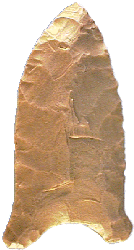

Point Type: QUAD
Also See: Arkabutla, Beaver Lake, Candy Creek, Cumberland, Dalton, Debert, Golondrina, Pelican, Shoop
Location: Southeastern United States
Associated Dates:
10,000-6000 B.P. - Late-Transitional Paleo & Early Archaic
Morphology: Auriculate
General Description: The Quad blade is a medium to large sized lanceolate point with flaring squared ears or auricles and a concave base that is ground. Most specimens show some basal thinning and a few are fluted. Recurvature of the blade is typical. The Quad point is believed to be related to the earlier Cumberland point. Quads are very similar in appearance to the Beaver Lake type however the Quad is shorter, broader, and has larger, more pronounced ears, and can have a abrupt or stubby appearance at the tip. The workmanship on the Quad point is not as fine as on the Beaver Lake. The Quad was made using random percussion flaking combined with some pressure retouching. Grinding in the hafting area varies from light or none, to very heavy and can include the ears, basal concavity and the blade edges sometimes running from one third to one half the way up the blade. The Quad is found all over the Southeastern United States but the center of distribution seems to be the Tennessee Valley and along the Tennessee River in Alabama. Early examples can show fluting on either or on both sides.
The size of Quad points can range from 39 mm to 78 mm in length. The Quad was named by Frank J. Soday for his work in and around the Quad site in Limestone County, Alabama.,
About the Point Above: The point pictured at the top of this page, was found in Southern Tennessee. It is made from light tan or coffee and cream colored flint. It is fluted on both sides. The flute on the photographed side is 21 mm in length while the flute on the opposite side is 17 mm in length. Overall, the point measures 58 mm in length, is 31 mm wide (across the ears or auricles) and is only 7 mm thick (mid blade at the point where the flutes end). The base measures 18 mm in width (inside the ears) and the concavity of the base is 6 mm deep. The base is ground as are the ears and blade edges running 22 mm up from the ears of the base. Close microscopic examination reveals rounding/polishing of most high ridges of the knapping scars, probably due to the natural effects of either erosion, abrasion, or weathering after discard or loss. The point has a soft satin luster and exhibits fine retouch flakes on blade edges. Catalog Number 6-154-H
References: Baker, Justice, Overstreet, Waldorf
© Copyright 1997 - 2008 LITHICS-Net WWW.LITHICSNET.COM
Use Your Browser's BACK Button to Return to the LITHICS-Net Index.